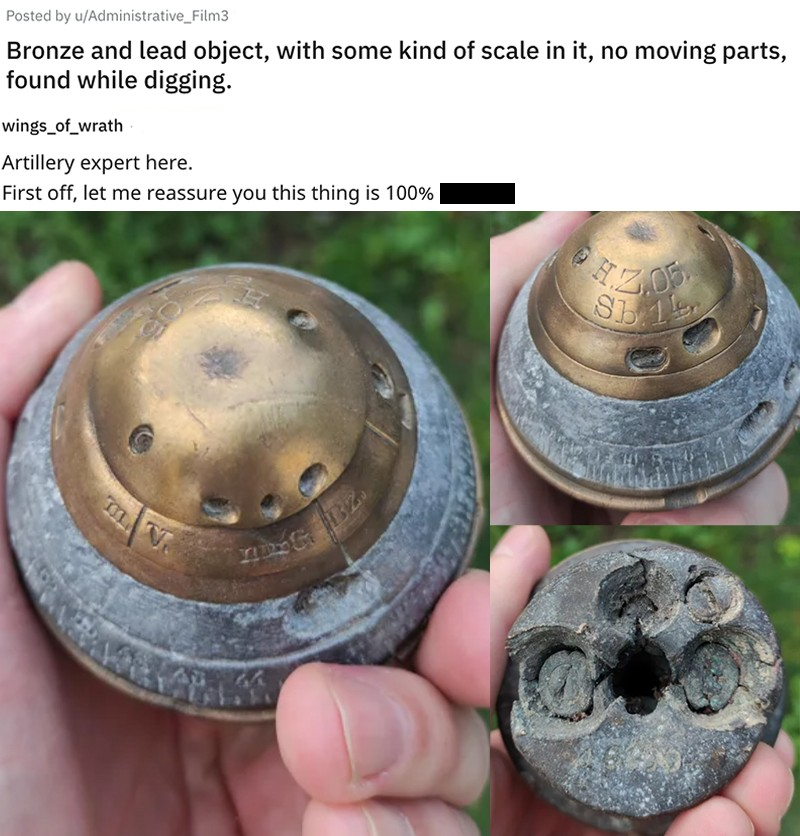Picture this: you’re out in your backyard, shovel in hand, digging up some dirt for a new garden bed or maybe a DIY project. Suddenly, your spade hits something hard. You brush away the soil, and there it is—a strange, metallic object, part bronze, part lead, with an air of history clinging to it. What is it? Where did it come from? If you’ve stumbled across something like this and posted it online—like Reddit user u/Administrative_Film3 did—you’re not alone in your curiosity. Turns out, this could be a relic from a bygone era, and the internet has some pretty cool answers. Let’s dive into the mystery of this bronze and lead object and figure out what it might be, based on some sharp-eyed Redditors and a bit of historical detective work.

A Reddit Discovery Sparks Intrigue
Imagine the thrill of unearthing something unexpected. That’s exactly what happened to u/Administrative_Film3, who shared a photo of their find on Reddit, asking, “What is this bronze and lead object? Found while digging.” The post caught the attention of the online community, and soon, responses rolled in. Two Redditors, u/feric51 and u/wings_of_wrath, stepped up with some compelling insights. Their consensus? This isn’t just random junk—it’s likely a German artillery fuse, specifically an H.Z.05 model from World War I. Now, that’s not something you find every day! But what does that mean, and why should you care? Let’s break it down.
Video: 12 Most Mysterious Recent Archaeological Finds And Artifacts Scientists Still Can’t Explain
Decoding the H.Z.05: A Piece of WW1 History
So, what’s an H.Z.05 fuse? The name might sound like a secret code, but it’s actually pretty straightforward once you crack it. “H.Z.” stands for “Haubitze Zünder,” German for “Howitzer Fuze,” and “05” marks it as a model from 1905. This little gadget was designed for German 10cm light field howitzers during World War I—a war that reshaped the world over a century ago. Think of it as the trigger for a big, explosive shell, a key player in the artillery battles that defined the trenches. Made with a brass top and a body of aluminum-zinc alloy, it’s a mix of durability and precision, built to withstand the chaos of war.
Redditor u/wings_of_wrath, who claims artillery expertise, pointed out its “triple effect” nature. That means it could detonate in three ways: a timed explosion (like a ticking clock), percussion without delay (boom on impact), or percussion with a slight delay (a sneaky aftershock). Pretty clever, right? It’s like a Swiss Army knife of destruction, adaptable to whatever the battlefield threw at it. But don’t worry—this one’s not going to blow up your living room. Let’s explore why.
Is It Safe? The Inert Factor

Here’s the million-dollar question: if you dig up something like this, should you panic? According to u/wings_of_wrath, the answer’s a resounding “no.” This particular H.Z.05 fuse is 100% inert—meaning it’s harmless now. How can they tell? The bottom’s all banged up and split, a telltale sign it’s already done its job and exploded long ago. Plus, the flame exhausts are burned out, and the detonator—that little explosive buddy that makes it go boom—is missing. It’s like finding an old, empty firecracker after the Fourth of July. Sure, it looks cool, but it’s not lighting up anytime soon.
So, what do you do with it? As u/wings_of_wrath suggests, you’ve got yourself a nifty paperweight. It’s a conversation starter, a tangible piece of history you can plop on your desk. But before you start showing it off, let’s dig deeper into what makes this find so fascinating.
The Materials: Bronze, Lead, and a Dash of War

Why bronze and lead? Well, technically, it’s brass (a bronze-like alloy) on top and an aluminum-zinc mix for the body, but the lead vibe comes from its weight and weathered look. Back in WW1, materials mattered. Brass was tough and corrosion-resistant—perfect for something that might sit in muddy trenches or get buried for a century. The aluminum-zinc alloy kept it light yet sturdy, a practical choice when you’re hauling artillery across battlefields. Together, they tell a story of wartime ingenuity, where every ounce and every inch had to count.
Finding something like this is like stumbling across a time capsule. It’s not just metal—it’s a snapshot of a moment when the world was at war, and engineers were racing to outsmart the enemy. But how did it end up in your backyard? That’s where the real adventure begins.
How Did It Get Here? The Journey Underground
Let’s play detective for a sec. You’re digging, and out pops this WW1 relic. How’d it get there? If you’re in Europe—say, near old battlegrounds like France or Belgium—it’s not a huge surprise. The Western Front was littered with artillery, and even today, farmers unearth shells and fuses from that era. Known as the “Iron Harvest,” these remnants still surface, a haunting echo of the Great War. But if you’re somewhere else—like the U.S. or Australia—it’s a bit more puzzling. Maybe a soldier brought it home as a souvenir, or it was part of a collector’s stash that got lost to time. Heck, it could’ve been tossed out decades ago and buried under layers of dirt.
Think about it: this little fuse survived a war, an explosion, and over 100 years underground, only to land in your hands. That’s some serious staying power! It’s like the Indiana Jones of artifacts—minus the fedora, of course. But what’s next for your find? Should you keep it, study it, or call in the pros?
What to Do With Your WW1 Treasure

So, you’ve got this cool, inert H.Z.05 fuse sitting on your table. Now what? First off, enjoy it! It’s not every day you get to hold a piece of history. You could clean it up a bit—gently, with a soft brush—to show off that brass shine, or leave it rugged for that authentic battlefield vibe. It’s already safe, so no need to freak out about explosions. Want to geek out more? Do what u/feric51 suggested and search “H.Z.05 fuze” online. You’ll find photos, diagrams, and maybe even stories from other diggers who’ve found similar treasures.
If you’re feeling extra curious, hit up a local museum or historical society. They might love to take a look, especially if you’re near a WW1-related site. Who knows? Your find could add a tiny piece to the puzzle of history. Or, just keep it as your own little secret—a quirky reminder that the past is never as far away as we think. Either way, you’ve got something special, and that’s worth celebrating.
Conclusion: A Small Find, A Big Story
So, what’s this bronze and lead object you found while digging? Thanks to some sharp Reddit sleuths, we’ve got a solid lead: it’s likely an H.Z.05 German artillery fuse from World War I, a triple-threat relic that’s now a harmless keepsake. Its brass top and aluminum-zinc body whisper tales of wartime innovation, while its banged-up state proves it’s already lived its explosive life. Whether it landed in your yard from a battlefield, a soldier’s pocket, or a forgotten collection, it’s a survivor—a tiny testament to a massive moment in time. You’ve unearthed more than just metal; you’ve dug up a story. So, what’s your next move? Keep it, share it, or dig for more? The choice is yours, but one thing’s for sure: history just got a lot closer to home.


